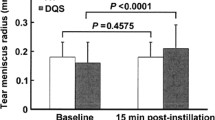Abstract
The aim of this study was to detect possible changes in the permeability of the corneal epithelium in dry eye patients treated with artificial tears. For this reason, corneal epithelial permeability was measured in 68 consecutive dry eye patients before and after 8 weeks of treatment with artificial tears by means of objective fluorophotometry (polyvinyl alcohol 1.4%+chlorobutanol 0.5%, 25 subjects; polyvinyl pyrrolidone 2%+ benzalkonium chloride 0.005%, 25 subjects; polyvinyl pyrrolidone 2% without preservative, 18 subjects). Before treatment, the stromal fluorescein uptake of dry eyes was three times higher than that of healthy control eyes. Eight weeks after the beginning of treatment the corneal epithelial permeability of patients treated with polyvinyl alcohol 1.4%+chlorobutanol 0.5%, as well as of those treated with polyvinyl pyrrolidone 2% without preservative, was reduced significantly (−44.9% and −43.4%, respectively; P < 0.001). However, patients who had been treated with polyvinyl pyrrolidone 2%+ benzalkonium chloride 0.005% showed no significant change in corneal epithelial permeability after treatment (−7.9%; P = 0.3).
Similar content being viewed by others
References
Araie M, Maurice D (1987) The rate of diffusion of fluorophores through the corneal epithelium and stroma. Exp Eye Res 44:73
Berkowitz R, Klyce S, Salisburg J, Kaufman H (1981) Fluorophotometric determination of the corneal epithelial barrier after pebetrating keratoplasty. Am J Ophthalmol 92:332
Brewitt H, Honegger H (1982) Morphologische Befunde des Hornhautepithels bei Störung des präkornealen Filmes und nach Applikation von Augenmedikamenten. Eine raster- und transmissionselektronenmikroskopische Untersuchung. In: Marquardt R (ed) Chronische Conjunctivitis. Trockenes Auge. Springer, Wien New York, pp 35–57
Brewitt H, Kunze G (1981) Zum Einfluß von Benzalkoniumchlorid auf die Wundheilung der Hornhaut — eine rasterelektronenmikroskopische Untersuchung. Contactologia 3:183
Bron AJ (1985) Prospects for the dry eye. Trans Ophthalmol Soc UK 104:801
Burstein NL (1980) Preservative cytotoxic threshold for benzalkonium chloride and chlorhexidine digluconate in cat and rabbit corneas. Invest Ophthalmol Vis Sci 19:308
Burstein NL (1984) Preservative alteration of corneal permeability in humans and rabbits. Invest Ophthalmol Vis Sci 25:1453
Burstein NL, Klyce SD (1977) Electrophysiologic and morphologic effects of ophthalmic preservatives on rabbit cornea epithelium. Invest Ophthalmol 16:899–907
Cadwallader DE, Ansel HC (1965) Hemolysis of erythrocytes by antibacterial preservatives. II. Quarternary ammonium salts. J Pharm Sci 54:1010
Ehrich W (1982) Konservierungsstoffe und Augentropfen. In: Marquardt R (ed) Chronische Conjunctivitis. Trockenes Auge. Springer, Wien New York, pp 273–286
Gilbard JP, Rossi SR, Heyda KG (1989) Ophthalmic solutions, the ocular surface, and a unique therapeutic artificial tear formulation. Am J Ophthalmol 107:348
Göbbels M, Spitznas M (1989) Influence of artificial tears on corneal epithelium in dry-eye syndrome. Graefe's Arch Clin Exp Ophthalmol 227:139
Göbbels M, Spitznas M, Oldendoerp J (1989) Impairment of corneal epithelial barrier function in diabeticis. Graefe's Arch Clin Exp Ophthalmol 227:142
Göbbels M, Goebels G, Spitznas M (1991) Tear flow and tear volume in normal and dry eyes. Invest Ophthalmol Vis Sci (in press)
Gold JB, Mathers WD, Lemp MA (1986) The effects of topical sodium hyaluronate solution on specular microscopic changes in the corneal epithelium of human subjects with keratoconjunctivitis sicca (KCS). ARVO Abstracts Invest Ophthalmol Vis Sci 27 [Suppl]:24
Green K, Tonjum A (1971) Influence of various agents on corneal permeability. Am J Ophthalmol 72:897
Kruijf EJFM de, Boot JP, Laterveer L, Best JA van, Ramselaar JAM, Oosterhuis JA (1987) A simple method for determination of corneal permeability in humans. Curr Eye Res 6:1327
Laflamme MY, Swieca R (1988) A comparative study of two preservative-free tear substitutes in the management of severe dry eye. Can J Ophthalmol 23:174
Lemp MA, Mathers WD (1986) The corneal surface in kerato-conjunctivitis sicca. In: Holly FJ (ed) The preocular tear film in health, disease, and contact lens wear. Dry Eye Institute, Lubbock, pp 840–846
Mandgal PC, Cornelis H, Missotten L (1981) Effects of commercial ophthalmic drugs on rabbit corneal epithelium. Graefe's Arch Clin Exp Ophthalmol 216:191
Norn MS (1986) The effect of drugs on tear secretion. In: Holly FJ (ed) The preocular tear film in health, disease, and contact lens wear. Dry Eye Institute, Lubbock, pp 221–229
Ohrloff C (1987) Permeabilität der zellulären Grenzschichten der Hornhaut in vivo. Fortschr Ophthalmol 84:307
Pfister RR, Burstein N (1976) The effects of ophthalmic drugs, vehicles, and preservatives on corneal epithelium: a scanning electron microscope study. Invest Ophthalmol 15:246
Ramselaar JAM, Boot JP, Haeringen NJ van, Best JA van, Oosterhuis JA (1988) Corneal epithelial permeability after instillation of ophthalmic solutions containing anaesthetics and preservatives. Curr Eye Res 7:947
Van Zutphen H, Demel RA, Norman AW, Deenen LLM van (1971) The action of polyene antibiotics on lipid bilayer membranes in the presence of serval cations and anions. Biochim Biophys Acta 241:310
Versura P, Maltarello MC, Stecher F, Caramazza R, Laschi R (1989) Dry eye before and after therapy with hydroxypropyl methylcellulose. Ultrastructural and cytochemical study in 20 patients. Ophthalmologica 198:152
Völker-Dieben HJ, Kok-van-Alphen CC, Hollander J, Kruit PJ, Batenburg K (1987) The palliative treatment of the dry eye. Doc Ophthalmol 67:221
Willis RM, Folberg R, Krachmer JH, Holland EJ (1987) The treatment of aqueous-deficient dry eye with removable punctal plugs. A clinical and impression-cytotoxic study. Ophthalmology 94:514
Wilson G, Bachmann WG, Call PL (1986) A nutritional role for tears. In: Holly FJ (ed) The preocular tear film in health, disease and contact lens wear. Dry Eye Institute, Lubbock, pp 978–987
Author information
Authors and Affiliations
Additional information
Offprint requests to: M. Göbbels
Rights and permissions
About this article
Cite this article
Göbbels, M., Spitznas, M. Effects of artificial tears on corneal epithelial permeability in dry eyes. Graefe's Arch Clin Exp Ophthalmol 229, 345–349 (1991). https://doi.org/10.1007/BF00170693
Received:
Accepted:
Issue Date:
DOI: https://doi.org/10.1007/BF00170693




